The Digital Public Infrastructure (DPI) Safeguards initiative, stewarded by the UN Secretary-General’s Envoy on Technology (OSET) and the United Nations Development Programme (UNDP), with the guidance of Working Groups composed of a global multi-stakeholder community of 44 DPI experts from public and private sectors, civil society, development agencies and academia released its interim report in April 2024.
As the Chief of Knowledge and Design at Societal Thinking, I find this UNDP interim report deeply resonates with our work. On a daily basis, our work focuses on how DPIs can accelerate progress toward societal good and how safe and inclusive systems can be reimagined and designed.
DPIs as Sustainable Development Goals (SDG) accelerator
I found this report highly informative and educational about the potential of DPI to accelerate the SDGs in countries. In my view, the societal changes required to achieve the SDGs in a short time are highly complex. DPIs can provide a mechanism for solving problems at scale and with speed by offering a unified approach for implementation across large populations. This report emphasises how DPIs can accelerate progress toward the SDGs by addressing these complex challenges. Their true value lies in delivering services at low or no cost, which saves both time and money. This efficiency can significantly improve the lives of underserved communities by enhancing access to essential services like education, healthcare, employment, and housing, thus promoting greater inclusion. When service delivery costs are high, low-income or low-margin populations are less likely to adopt them, which creates a cascading effect on their ability to improve livelihoods. DPIs, however, can eliminate these barriers by making services affordable or free, encouraging wider adoption and fostering inclusion, and ultimately improving access to critical resources for underserved populations.
Over the past decade and a half, I have witnessed this shift in India. At Societal Thinking, I am co-travelling with various missions on their journey to create impact at a population scale and have had the opportunity to observe how DPIs developed in India serve as potential levers for solving problems at scale, with speed, and sustainably.
I have been a keen observer of the evolution of Aadhaar, the unique national ID, which has served as the foundation for numerous innovations across various sectors, driving efficiency, transparency, and accessibility. Aadhaar’s integration with Jan Dhan accounts (under Prime Minister Jan Dhan Yojana) has expanded financial inclusion by ensuring that people in remote areas have access to formal banking services. The implementation of Aadhaar helped ascertain the KYC (Know Your Customer) process to open bank accounts and led to financial digitisation through Unified Payment Interface (UPI) integration. This accelerated the opening of bank accounts, with penetration increasing from 20% to 80% of citizens over 8-9 years, enabling direct benefit transfers from the government to citizens during the pandemic. This outcome aligns with SDGs 8 and 9 and exemplifies the foundational principles mentioned in the interim report, such as reinforcing transparency and accountability and safeguarding the rule of law.
The Aadhaar initiative was designed to provide a unique digital ID to every citizen. While it wasn’t specifically created for education, its integration into government services and schemes has indirectly supported the achievement of SDG 4, which focuses on ensuring inclusive and equitable quality education and promoting lifelong learning opportunities for all. Aadhaar has streamlined the distribution of scholarships, subsidies, and educational grants to eligible students by linking their accounts with Aadhaar numbers. It has also been used to track and monitor student enrollment, drop-out rates, and attendance, enabling the government to target interventions aimed at keeping children in school. Overall, Aadhaar has facilitated a more efficient, transparent, and targeted approach to educational schemes, ensuring that marginalized populations benefit as intended.
DPIs with guardrails are an accelerator
One of the key aspects of this report is the way it articulates fundamental propositions as a set of principles – foundational and operational principles – totalling 18 propositions. These principles create a common vocabulary to foster a shared understanding of concepts and enable sustained cooperation.
The report highlights the risks to marginalised populations. These could be normative, institutional and technical risks and across country and individual levels. In India’s case, I have observed an iterative process of test-learn-iterate. One example in this context is the Public Distribution System (PDS), one of the largest food security networks in the world, which uses Aadhaar authentication to verify beneficiaries and prevent leakages, ensuring that food grains reach eligible individuals. Initially, there were challenges with the PDS’s interoperability and ability to scale across different states, particularly in remote areas. The system often struggled with network connectivity, causing delays in transactions and excluding those who lacked digital literacy or access to mobile networks. Each state had its own PDS infrastructure, making it difficult for beneficiaries, especially migrants, to access rations across state lines. To address these issues, the National Portability (One Nation, One Ration Card) initiative was launched to integrate all state PDS systems, allowing beneficiaries to access food grains from any fair-price shop across India, regardless of their location.
Another major challenge was that the biometric-based Aadhaar authentication system faced difficulties in rural and remote areas due to inconsistent internet connectivity and server failures, which led to the exclusion of the poorest households from accessing rations. To resolve this, offline authentication mechanisms were introduced, such as QR code-based e-Aadhaar and Aadhaar Offline KYC. These approaches allowed users to verify their identity without relying on real-time online systems and still access PDS services.
These examples align well with the foundational principles mentioned in the interim report, such as reinforcing transparency and accountability and ensuring inclusivity.
DPIs enable social change agents to serve society
DPIs, when implemented with the right safeguards, have the potential to build and enhance trust and inclusion within systems. Many social entrepreneurs have leveraged national-level DPIs to create innovative solutions that impact healthcare, livelihood opportunities, education access, disaster recovery, and more. This is one of the motivations behind our work at Societal Thinking, where we advocate for the safe and transparent implementation of DPIs to create pathways for inclusive communities. By applying the principles outlined in the report, we aim to improve outcomes in education, health, livelihoods, gender equality, and climate action, not only in India but also in other developing economies around the world.
At Societal Thinking, I also oversee a Scaler programme where we collaborate with system orchestrators to learn, reimagine, and design new approaches to solving problems at scale, with speed, and sustainably. Haqdarshak is one such scaler where these principles have been effectively leveraged.
Haqdarshak’s mission is to make access to government welfare schemes easy, transparent, and hassle-free. They leverage foundational DPIs like Aadhaar and PAN-linked (Permanent Account Number) bank accounts to help individuals discover their eligibility for government schemes and enrol for benefits such as pensions, medical insurance, school scholarships, and loan subsidies for small-scale businesses. Haqdarshak has impacted 6.5 million citizens, including women, rural entrepreneurs, daily wage workers, sanitation workers, and micro-enterprises across 24 states in India while addressing SDGs 1, 2, 3, 8, 10, and 17.
How to build safe and inclusive systems in a country
With great power comes great responsibility. While DPI holds tremendous potential, the harms and risks are equally real. These are some key takeaways that I apply in my day-to-day work within the DPI ecosystem:
- Focus on inclusivity and safety of communities
- Bringing the ecosystem together
- Co-create and iterate with the community
With a “do-think-do” mindset focussed on continuous innovation and experimentation, DPI is not a one-time solution but an evolving ecosystem and so is safety and inclusion. Keep iterating and keep evolving.
Image credit: https://www.dpi-safeguards.org/
 Back
Back


